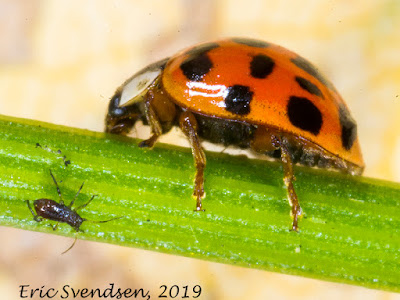The meadow spittlebug
 |
| Left: Meadow spittlebug nymph encased in spittle. Right: Grassy area with spittlebugs |
When
camping, I enjoy going for a walk in any available natural areas close to
me. It usually means grabbing a camera
and lens combination and heading out to explore what flora and fauna await
discovery. Yesterday I took an APS-C DSLR
camera equipped with a 105 mm macro lens.
It was also equipped with a macro flash unit. This combination has always served me well
for my macro stuff.
I came
to an abandoned field, once a golf course, and came upon a remarkable
sight. Spittlebugs. OK, so maybe they are not so amazing in
themselves, but this was different because there were thousands upon thousands
of them. The grass was teeming with
them. Some areas of grass were
unaffected, but here and there were countless numbers. You can see in the right photo above a small sample
of this; multiply it by a couple of thousand and you have an idea of the scope. Did I mention it was remarkable?
I
pulled one stem of grass up and blew away some of the bubbles. Under its frothy canopy was the meadow
spittlebug; the insect which created the bubbly mass. It is only the nymph (juvenile form of an
insect with incomplete metamorphosis) which lives in the spittle. It secretes mucus which it mixes with waste
products and whips the concoction up into the resulting froth. It provides protection against desiccation and
keeps it from being detected by predators.
Adult
spittlebugs are sometimes called froghoppers.
One species in this family has the record for jumping distance as it can
cover 40x its own length. If a six foot
human had this same ability, they would be able to cover a distance of 240
feet; only 20 yards shy of the length of a football field. Mind you, the person may have to spend their
childhood and adolescence in a frothy encasement made of their own physical
wastes and mucus secretions. I don’t
think the ability would be worth the sacrifice.
Just saying.



Comments
Post a Comment